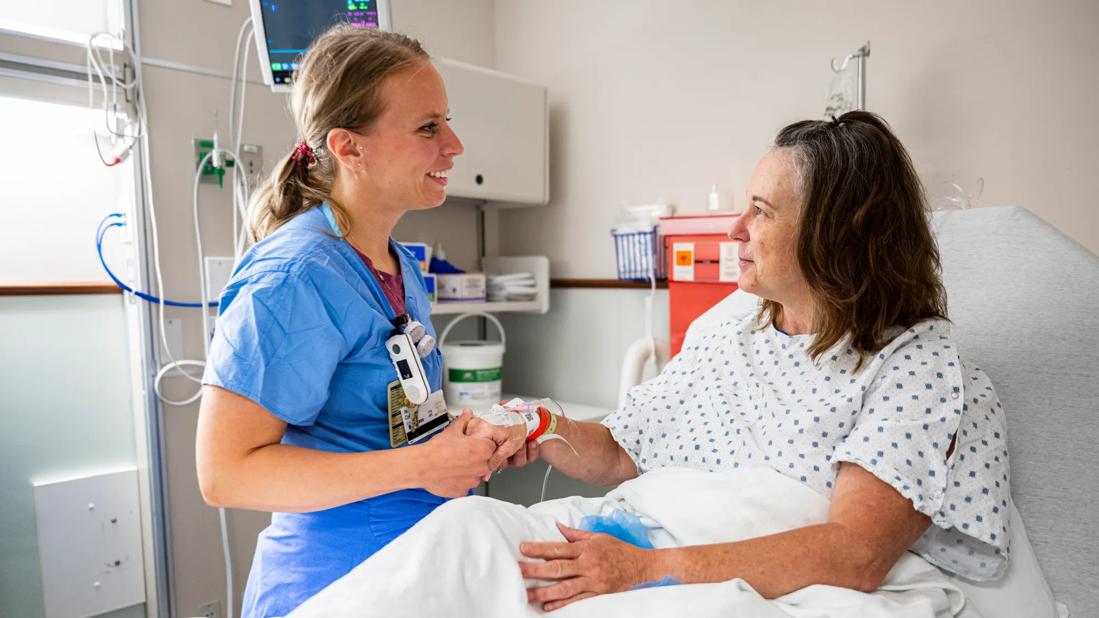Nursing team model incorporates assistance from clinical and nonclinical personnel

Innovative thinking and new approaches to nursing care are helping hospitals respond nimbly to the combined challenges of a worldwide pandemic and workforce shortages. At Cleveland Clinic, the reintroduction and evolution of team-based nursing care have enabled the continued delivery of optimal care for patients and a supportive professional environment for nurses during surges.
Advertisement
Cleveland Clinic is a non-profit academic medical center. Advertising on our site helps support our mission. We do not endorse non-Cleveland Clinic products or services. Policy
“It’s imperative that we maintain continuity in hospital operations, regardless of surge activity,” says Matthew Slife, CPA, PMP, Executive Director of Nursing Operations at Cleveland Clinic. “When it comes to managing workforce demands, flexibility is key to accommodating the needs of every patient who seeks our help.”
Cleveland Clinic’s primary nursing model assigns one RN to be the primary caregiver for a set number of patients based on census and patient acuity. There are few tasks that the RN will delegate to unlicensed clinical personnel in this model.
Team nursing involves deploying other caregivers to assist the primary nurses and allows them to expand the number of patients in their care. “This helps spread the workload out to a larger group of caregivers,” says Maureen Schaupp, MSN, APRN, CNP, CHFN, Associate Chief Nursing Officer, Advanced Practice and Nursing Quality and Practice. “Although the RN is still the patient’s primary caregiver, they can delegate some of their tasks to other team members.”
This model provides flexibility during times of crisis, such as pandemics and natural disasters.
“Our goal is to keep nurses performing tasks at the highest scope of their licensure by providing clinical and nonclinical support,” Slife says. “This team approach allows us to extend the care a single nurse can provide, so they’re able to increase the number of patients they’re responsible for and meet patient care goals.”
While Cleveland Clinic plans to return to the primary nursing model, the health system will continue to reinforce skills used in the team-based model to strengthen workforce flexibility.
Advertisement
“Team nursing extends the knowledge of our most experienced caregivers across a larger set of patients, and we’ll continue to analyze how this affects outcomes,” Slife says. “Whatever models we explore, we need more repetition to build that muscle memory into our teams.
A team nursing approach may prove helpful when we’re unable to meet our planned RN-to-patient ratios.”
Outside of the emergency department, the largest influx of patients tends to occur in the medical-surgical and intensive care units. In these areas, directors, managers and nursing operations managers help coordinate nursing assignments with the Central Staffing Office to best support patient care.
Under the team approach, a variety of employees may be redeployed:
In support of this program, advanced practice registered nurses and certified nurse anesthetists have worked beyond their full-timeequivalent roles by providing extra hours at the patient’s bedside.
“Caregivers had varying levels of experience and time away from clinical work when we began implementing the team model. Nurses were able to return or be introduced to the area of care where they were most comfortable,” says Slife. “We’ve tailored the placements and education to fit each person’s unique background and skills.”
Advertisement
Team nursing leverages the strengths of each caregiver on the team, Slife says. “Throughout the process, both the receiving units and our redeployed caregivers have been very flexible and accommodating to meet our patients’ needs,” he says.
“With new staff coming in to support the units, we took time to educate, upskill and reorient caregivers,” Slife says. “Our nursing education team coordinated additional training classes during nights and weekends to help everyone get up to speed.”
Initial challenges included coordinating schedules and timekeeping. Eventually, these issues resolved so that caregivers and managers had a smooth experience.
Schaupp and Slife say the following actions can help any health organization pivot to a team-based approach:
In addition to enhancing patient care, the team-based approach used at Cleveland Clinic has had a positive effect on nurses, both personally and professionally.
“We’ve repeatedly heard how much our nurses and caregivers felt like the entire enterprise was behind them during this challenging time,” says Schaupp. “As their interaction with patients and coworkers has increased, we’ve seen a significant increase in self-fulfillment for caregivers transitioning to bedside roles. Everyone’s professional network has grown as they’ve deepened their appreciation for what their colleagues do throughout the system.”
Advertisement
Cleveland Clinic nurses take great pride in their work, says Schaupp. They want to go the extra mile.
“It can be hard for a nurse when they don’t have an extra five minutes to talk to a patient who may need a listening ear,” she explains. “But when extra caregivers can come in and provide holistic care, this really gives nurses peace of mind.”
Advertisement
Advertisement

Nurses harness cutting-edge technology as a bridge to healing

Project aims to improve patient care by streamlining caregiver transitions

Optimizing care while protecting patients from life-threatening reactions

Palliative nurses improve quality of life

Strong bonds and momentous milestones fuel life-changing work

Experts offer hands-on support and education

Special skills course aims to improve patient safety and comfort while building caregiver confidence

Bariatric nurses deliver sensitivity, compassion and skill